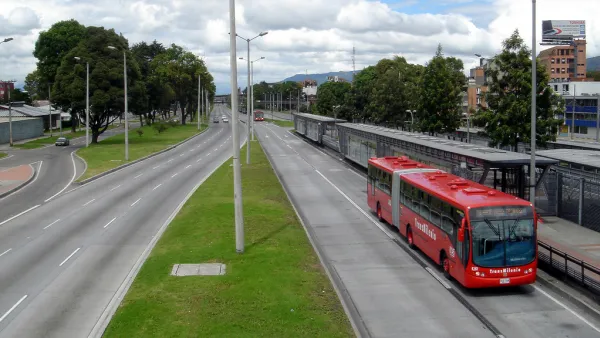In spite of international recognition from planners and transit officials, Bogotá's bus rapid transit system faced riots this month over high fares and overcrowding, Eric Jaffe reports.
Riders of TransMilenio, Bogotá's widely acclaimed bus rapid transit system, rioted in protest over a lack of transportation options earlier this month, destroying five bus stations and bringing out roughly 1,200 law enforcement officers. Complaints centered around high fares and overcrowding.
According to Jaffe, public dissatisfaction with the system began as early as 2004, just four years after the system opened. While the system garnered acclaim from planners around the world for cutting carbon emissions, reducing traffic fatalities nearly 90 percent, and slimming travel time by as much as a third in some corridors, rider experience was less than glowing.
"At rush hour, stations are so packed that people can't get off the bus, let alone on it," Jaffe writes. "Meanwhile the fare, at $1, is considered high for a city whose low-income users earn daily salaries only three times that, on average."
Furthermore, development of the system has been hampered by constrained funding: at present, TransMilenio covers only half of the footprint that it was slated to cover a year ago. It must also compete with "the city's decades-long, unrequited obsession with building a metro system that would cost much more than bus-rapid transit and cover far less of the city."
FULL STORY: Why Are People Rioting Over Bogota's Public Transit System?

National Parks Layoffs Will Cause Communities to Lose Billions
Thousands of essential park workers were laid off this week, just before the busy spring break season.

Retro-silient?: America’s First “Eco-burb,” The Woodlands Turns 50
A master-planned community north of Houston offers lessons on green infrastructure and resilient design, but falls short of its founder’s lofty affordability and walkability goals.

Delivering for America Plan Will Downgrade Mail Service in at Least 49.5 Percent of Zip Codes
Republican and Democrat lawmakers criticize the plan for its disproportionate negative impact on rural communities.

Test News Post 1
This is a summary

Test News Headline 46
Test for the image on the front page.

Balancing Bombs and Butterflies: How the National Guard Protects a Rare Species
The National Guard at Fort Indiantown Gap uses GIS technology and land management strategies to balance military training with conservation efforts, ensuring the survival of the rare eastern regal fritillary butterfly.
Urban Design for Planners 1: Software Tools
This six-course series explores essential urban design concepts using open source software and equips planners with the tools they need to participate fully in the urban design process.
Planning for Universal Design
Learn the tools for implementing Universal Design in planning regulations.
EMC Planning Group, Inc.
Planetizen
Planetizen
Mpact (formerly Rail~Volution)
Great Falls Development Authority, Inc.
HUDs Office of Policy Development and Research
NYU Wagner Graduate School of Public Service



























